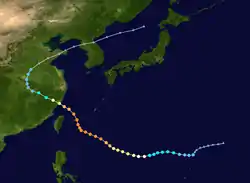Typhoon Fred (1994)
Super Typhoon Fred, known in the Philippines as Typhoon Susang, was a powerful and destructive tropical cyclone that made landfall in southern China during the 1994 Pacific typhoon season. It was the worst storm to hit Zhejiang in 160 years.[1]
| Typhoon (JMA scale) | |
|---|---|
| Category 4 super typhoon (SSHWS) | |
 Super Typhoon Fred at peak intensity | |
| Formed | August 12, 1994 |
| Dissipated | August 23, 1994 |
| Highest winds | 10-minute sustained: 185 km/h (115 mph) 1-minute sustained: 240 km/h (150 mph) |
| Lowest pressure | 925 hPa (mbar); 27.32 inHg |
| Fatalities | Over 1,000 |
| Damage | Over $1 billion (1994 USD) |
| Areas affected | Philippines, Taiwan, China |
| Part of the 1994 Pacific typhoon season | |
Meteorological history


The sixth storm of the 1994 Pacific typhoon season formed from a tropical disturbance and became a tropical depression on August 13. The system was designated 19W by the Joint Typhoon Warning Center. On August 15, Tropical Depression 19W became a tropical storm over the open West Pacific. It intensified to a tropical storm, and was given the name Fred. Fred tracked westward, slowly intensifying to a typhoon on August 16. By August 17, the system originated in the Philippines Sea approximately 823 miles (1,324 km) miles southeast of Kaohsiung, Taiwan.
The warm waters of the Pacific allowed the system continue to rapidly strengthen, becoming a Category 2 typhoon on August 18. At 8:00 that evening, Typhoon Fred strengthened to a Category 3 typhoon with winds of over 115 miles per hour (185 km/h) (equivalent to a U.S major hurricane). By midnight of August 19, Fred reached Category 4 intensity (winds greater than 130 miles per hour (210 km/h) on the Saffir-Simpson hurricane scale). Typhoon Fred reached its maximum intensity of 150 miles per hour (240 km/h) and a minimum central pressure of 925 millibars (27.3 inHg). Weather reconnaissance flights conducted by the Joint Typhoon Warning Center indicated that Super Typhoon Fred was in great size − 600 miles (970 km) across.
By the morning of August 20, as Super Typhoon Fred swiftly bore down Taipei, Taiwan, it was clear that the tropical cyclone was following former scenario. Warnings were issued in Taiwan. However, it turned away and headed for China. It made landfall in China, on August 21, as a strong category 2 typhoon with winds of 105 miles per hour (169 km/h). The storm caused significant damage and over 1,000 deaths. Super Typhoon Fred dissipated on August 22.[2]
Preparations and impact
In Taiwan, authorities issued evacuation warnings for low-lying areas and flash flood alerts were issued for mountainous communities. However, it turned away and headed straight towards China.
The storm made landfall in Zhejiang, on August 21, as a strong category 2 typhoon. High winds and flooding destroyed many buildings. Flooding killed many people. However, the rain relieved severe droughts in China. Damage to farmland, buildings, power lines and roads, and thousands of factory closures, leaves Zhejiang facing an estimated economic loss of $1 billion (1994 USD). Typhoon Fred killed more than 700 people in China's eastern Zhejiang Province and caused damage estimated at $1.16 billion (1994 USD). In total, Fred killed more than 1,000 people in the province.
References
- "BREAKING NEWS: TYPHOON FRED MAKES LANDFALL IN CHINA". Typhoon, floods, drought cost China huge losses Associated Press. August 1994. Archived from the original on 2012-04-06.
- Typhoon Fred. Encyclopedia of hurricanes, typhoons and cyclones. 1994. ISBN 9781438118796.
